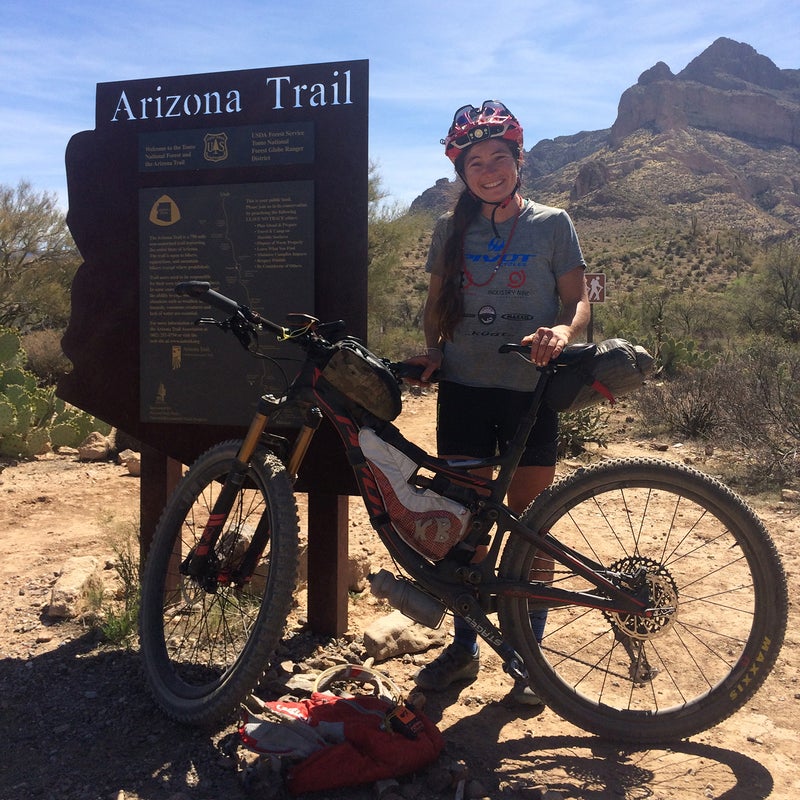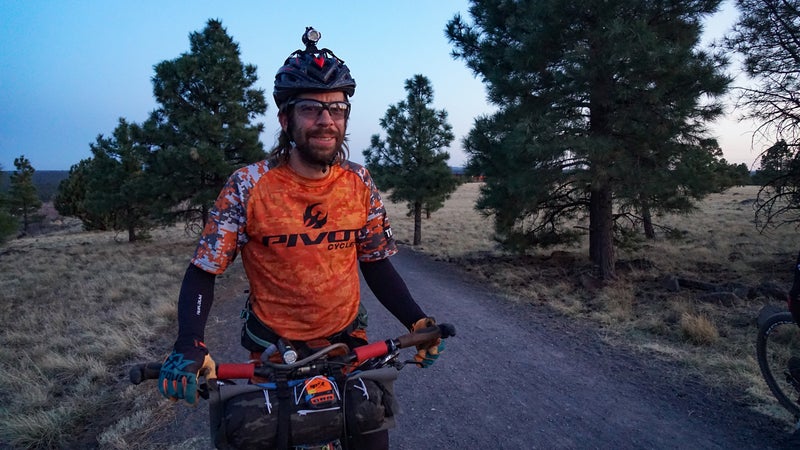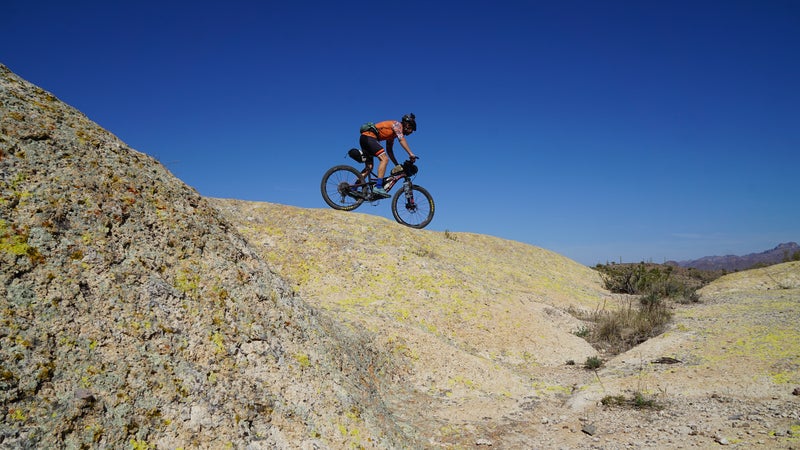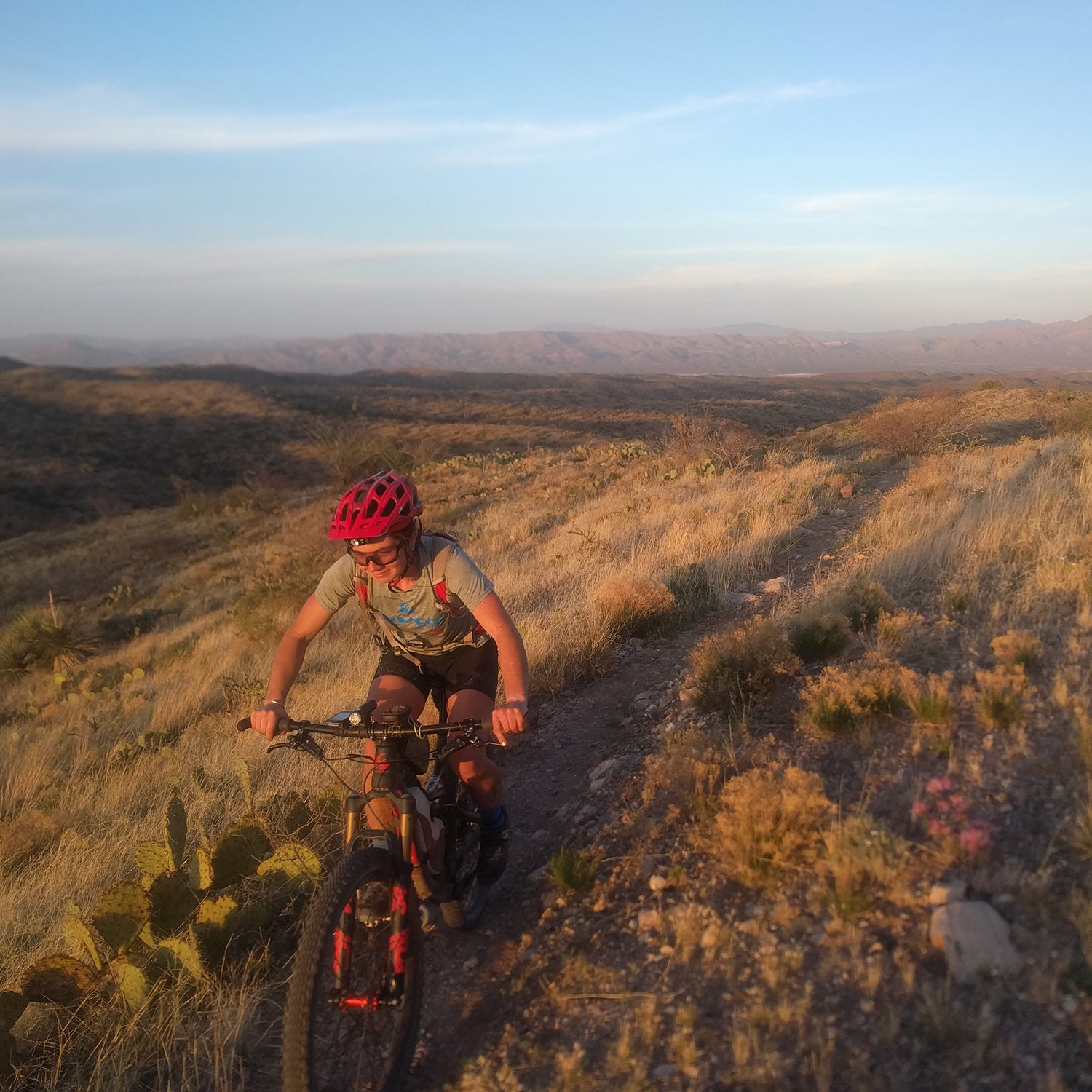Despite sizzling conditions, with temperatures in the high 80s, this year saw a slew of fast times at the 760-mile and the shorter AZT300, with new records at both events set on the trail that traverses Arizona from the Mexico to Utah borders.
Headlines belonged to Kaitlyn Boyle, a 30-year-old from Prescott, Arizona, who finished as the first woman and second overall in the AZT300, which covers the first 300 miles of the route, from Parker Canyon Lake, near the Mexico border, to Superior, outside Phoenix. Boyle’s time of two days, two hours, and 57 minutes (50:57) not only lopped more than ten hours off the five-year-old women’s course record—already considered a fast time—but is also the fourth-fastest known time on the course. In all, she outpaced 76 other riders. (The overall winner was four-time race veteran Neil Beltchenko, who finished in one day, 23 hours, and 13 minutes (47:13), the second-fastest time ever recorded. It was an impressive showing after his win in late February at the .)

Simply finishing the AZT300 is a feat in itself, which makes Boyle’s success that much more impressive. The route traverses brutal Sonoran Desert, with razor-sharp plants and rocks that want to slice open tires and skin, all the way to the 9,000-foot top of Mount Lemmon and back down again, making for massive elevation gain and wild weather fluctuations. The event is self-supported, which leads to heavy loads on steep, technical singletrack. Attrition is massive: At the time of writing, with the race still going on, some 45 percent of the field had already quit.
“It feels good to finally achieve what I know I’m capable of,” Boyle says. She has started the AZT four times but finished only once, in 2015, when she covered the course in almost three days. “Kaitlyn’s ride is impressive because of her previous failed attempts,” says Scott Morris, AZT race director, who himself once held the course record. “It’s especially satisfying when someone keeps trying, encounters bad luck, but eventually triumphs.”
Boyle says that in the run-up to the race, she was initially aiming for a sub-60-hour finish. “But I didn’t feel super inspired. When I thought about what would change that, what would motivate me, I realized that I wanted to try to go as fast as the guys go.” Three weeks before the start, Boyle dropped her goal to 48 hours.
Her confidence wasn’t unfounded: Earlier in the season, Boyle set a women’s course record at the , with a time that would have put her third in the men’s race. She’s been racing (and doing well in) ultra-distance mountain bike races since 2012. Boyle was also inspired to set such an ambitious goal for herself by her “ex-turned-best” friend Kurt Refsnider, who holds the record of 45 hours and 7 minutes on the AZT. “Having spent a lot of time with Kurt, who is one of the strongest men out there at this stuff, I realized, yeah, he’s great and he’s talented, and I have learned a lot from him…but he’s not beyond me,” Boyle says.
“I think my ride illustrates the power of a vision,” she says. “You will never do it unless you imagine it.” Boyle also hopes her performance will inspire more women to compete in similar events. “In ultra-endurance sports, where mental strength can override certain physiological factors like power, women are on an equal playing field as men. We just need to believe it and not limit ourselves.”
Boyle also believes she can go faster. “I lost a few hours because I never slept and started falling apart because of it,” she says. “But honestly, my 51 hours is more of a success to me than if I’d had the perfect race in 48. To have had a breakdown late in the race and then come back and finish strong was the real victory.” Boyle says that although she initially didn’t think she would return to the AZT300, now she foresees coming back someday. “Not next year,” she says. “But I think I’ll be back. I can go faster.”

Less than two hours after Boyle finished in Superior, her friend and inspiration, Refsnider, came through the Superior finish line in third place, but he didn’t stop long to celebrate. The 36-year-old was leading the full 760-mile Arizona Trail Race (AZTR), which runs concurrently with the 300 but continues on to the Utah border, including crossing Grand Canyon on foot with your bike on your back. Refsnider set the fastest known time on this behemoth during an individual time trial (ITT) in 2010 (Beltchenko bested it in 2016), but he hadn’t been back since. This year, just four days after he congratulated Boyle at the Superior finish of the 300, Refsnider set a new course record on the full course, finishing in an eye-watering six days, six hours, and six minutes (150:06), shaving more than six hours off Beltchenko’s time.
“Both Kurt’s and Kaitlyn’s performances embody the principles that the race was founded on: traveling fast and light in a self-supported manner,” Morris says. “As for Kurt, it’s always nice to see someone put together a flawless ride on what can be such a challenging trail.
To win, Refsnider slept around two hours per night, for a total of just 12 hours during his 150-hour run. He felt strong for the first five days but says the last 30 hours were tough. “After I had a nap north of Flagstaff, I decided I would push all the way to the border, including the canyon, without stopping,” Refsnider says. “It was probably a little audacious.” On his hike out of Grand Canyon, which he tackled overnight, Refsnider began hallucinating river otters and Chinese writing on rocks. Once out of the canyon and national park and falling asleep at the wheel, he stopped for a nap. After four minutes, a raven landed at his side and woke him—Refsnider admits that might have been a hallucination, too—but the brief rest was enough of a reset to carry him the remaining few hours to the border.

“It nearly broke me the first time,” Refsnider says of his 2010 ITT. The course was virtually unknown back then, so he had no beta on water and food sources and no times for reference. Twice, he ran out of food. “This was a much more focused ride. More mature,” Refsnider says. “I went hard when I knew I could, but slowed down and was patient when I had to. That was the biggest difference—my mentality. It was the most fun I’ve ever had racing an ultra.”
But it wasn’t enough fun that he’ll return. “Nope, never again,” Refsnider says. “Even if someone comes along and does it faster, I’ll just congratulate them. This was as close to a perfect run as you get. There’s nothing I could ever stand to gain.”


